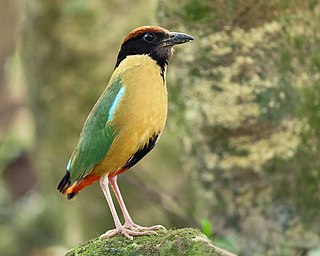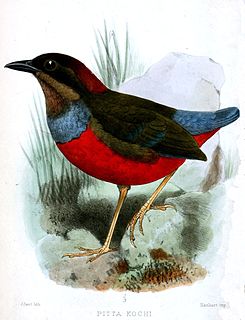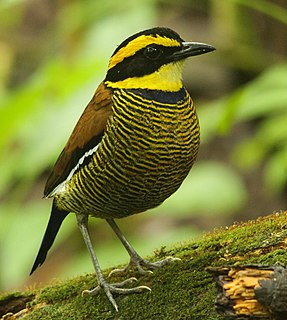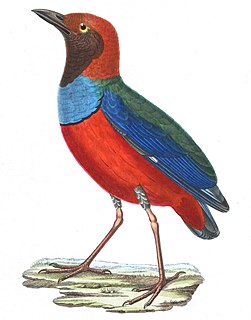
Pitta is a genus of birds in the Pittidae, or pitta family. They are secretive, brightly coloured birds that forage on the forest floor. They are long-legged and short-tailed with rounded wings. They all have green on their upperparts with blue wing-patches. Many have dark heads. Nest construction, incubation and rearing of nestlings is performed by both parents. Incubation is completed in some 17 days, and the nestlings are altricial and nidicolous. Some species are migratory.

The blue-banded pitta is a species of bird in the family Pittidae. It is endemic to the island of Borneo, where it is found in all three countries that share the island: Malaysia, Brunei and Indonesia. Its natural habitat is subtropical or tropical moist lowland forest.

The Sula pitta is a species of the pitta. It was considered a subspecies of the red-bellied pitta. It is endemic to Indonesia where it occurs in the Sula and Banggai Islands. Its natural habitat is subtropical or tropical moist lowland forests. It is threatened by habitat loss.

The Philippine pitta or blue-breasted pitta, is a species of bird in the family Pittidae. It has a pointed beak and has a red belly with a green blue band above. It is found in Indonesia and the Philippines. Its natural habitat is subtropical or tropical moist lowland forest. It was considered the nominate subspecies of the red-bellied pitta. This species has a wingspan of 20 - 25cm and is 17.5 - 20cm tall. In the class Aves it lays eggs and has feathers covering its entire body, it also has wings and can fly. As the illustration on your right shows it has short tail feathers and has a small brown head.

The garnet pitta is a species of bird in the family Pittidae. It is found in Brunei, Indonesia, Malaysia, Myanmar, Singapore, and Thailand. Its natural habitat is subtropical or tropical moist lowland forest. It is threatened by habitat loss. The form occurring in the Malaysian state of Sabah has been split as the black-crowned pitta.

The whiskered pitta is a rare species of bird in the family Pittidae. It is endemic to Luzon in the Philippines.

The blue-winged pitta is a passerine bird in the family Pittidae and Southeast Asia. It forms a superspecies with three other pittas, the Indian pitta, the fairy pitta and the mangrove pitta. A colourful bird, it has a black head with a buff stripe above the eye, a white collar, greenish upper parts, blue wings, buff underparts and a reddish vent area. Its range extends from India to Malaysia, Indonesia, southern China and the Philippines. Its habitat is moist woodland, parks and gardens and it avoids dense forest. It feeds mainly on insects and worms. It breeds in the spring, building an untidy spherical nest on the ground, often near water and between tree roots. A clutch of about five eggs is laid and incubated by both parents, hatching after about sixteen days.

The graceful pitta, sometimes alternatively known as the black-crowned pitta (although another species is more regularly called black-crowned pitta, is a species of bird in the family Pittidae which occurs in Sumatra, Indonesia. Its natural habitat is subtropical or tropical moist montane forests. It is threatened by habitat loss.

The black-crowned pitta, also known as the black-headed pitta, black-and-crimson pitta, black-and-scarlet pitta or black-crowned garnet pitta, is a brightly coloured, ground-dwelling, bird species in the pitta family. It is endemic to the Southeast Asian island of Borneo. It was described by John Gould in 1877, with the type locality recorded as the Lawas River in northern Sarawak.

Hydrornis is a genus of pitta in the family Pittidae. The genus contains thirteen species, found in South-east Asia. The genus was formerly merged with the genus Pitta, but a 2006 study split the family into three genera.

The Sulawesi pitta is a species of pitta. It was considered a subspecies of the red-bellied pitta. It is endemic to Indonesia where it occurs in Sulawesi, Manterawu, and Togian Islands. Its natural habitat is subtropical or tropical moist lowland forest. It is threatened by habitat loss.

The Siau pitta or Siao pitta is a species of the pitta. It was considered a subspecies of the red-bellied pitta. It is endemic to Indonesia where it occurs in Siau and Tagulandang. Its natural habitat is subtropical or tropical moist lowland forests. It is threatened by habitat loss.

The Sangihe pitta is a species of the pitta. It was considered a subspecies of the red-bellied pitta. It is endemic to Indonesia where it occurs in the Sangihe Islands. Its natural habitat is subtropical or tropical moist lowland forests. It is threatened by habitat loss.
The South Moluccan pitta is a species of pitta. It was formerly considered a subspecies of the red-bellied pitta. It is endemic to Indonesia where it occurs on Buru and Seram. Its natural habitat is subtropical or tropical moist lowland forests. It is threatened by habitat loss.

The North Moluccan pitta is a species of the pitta. It was considered a subspecies of the red-bellied pitta. It is endemic to Indonesia where it occurs on the northern Moluccas. Its natural habitat is subtropical or tropical moist lowland forests. It is threatened by habitat loss.
The Louisiade pitta is a species of the pitta. It was considered a subspecies of the red-bellied pitta. It is endemic to the Louisiade Archipelago in Papua New Guinea. Its natural habitat is subtropical or tropical moist lowland forests. It is threatened by habitat loss.
The Bismarck pitta or New Ireland pitta is a species of the pitta. It was considered a subspecies of the red-bellied pitta. It is endemic to the New Ireland Province in Papua New Guinea. Its natural habitat is subtropical or tropical moist lowland forests. It is threatened by habitat loss.

The Papuan pitta is a species of pitta. It was formerly considered a subspecies of the red-bellied pitta. It is found in the Aru Islands, New Guinea and the northern Cape York Peninsula. Its natural habitat is subtropical or tropical moist lowland forest. It is threatened by habitat loss.
The Tabar pitta is a species of the pitta bird. It was considered a subspecies of the Bismarck pitta, and some taxonomic authorities still consider it so. It is endemic to the Tabar Group in Papua New Guinea. Its natural habitat is subtropical or tropical moist lowland forests. It is threatened by habitat loss.
The New Britain pitta is a species of the pitta. It was considered a subspecies of the Bismarck pitta, and some taxonomic authorities still consider it so. It is endemic to New Britain in Papua New Guinea. Its natural habitat is subtropical or tropical moist lowland forests. It is threatened by habitat loss.














